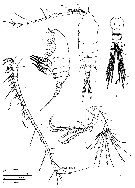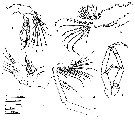|
|
 |
|
Calanoida ( Order ) |
|
|
|
Clausocalanoidea ( Superfamily ) |
|
|
|
Aetideidae ( Family ) |
|
|
|
Aetideopsis ( Genus ) |
|
|
| |
Aetideopsis rhinoceros McKinnon, Corley & Duggan, 2011 (F,M) | |
| | | | | | | Ref.: | | | McKinnon, Corley & Duggan, 2011 (p.833, figs.F,M) |  issued from : A.D. McKinnon, J. Corley & S. Duggan in Crustaceana, 2011, 84 (7). [p.835, Fig.2]. Female (from 14.05°S, 121.85°E): a-b, habitus (dorsal and lateral, respectively); c, urosome (ventral); d, A1; e, A2. Nota : Prosome 3.2 times as long as urosome (measured along dirsal mid-line) - Rostrum bifurcate, fused to cephalosome, right ramus strongly produced into a recurved horn (175 µm long), left ramus (± 22 µm long). - A frontal organ comprising 2 large integumental organs at dorsal base of tostrum. - Posterior corners of prosome produced into acute points extending just short of end of genital-double somite. - Surface of cephalosome and thoracic somites covered with dome-shaped protuberances (about 2 µm in diameter). - Genital double-somite symmetrical, as long as wide. - Urosomites 1-2 with denticulate fringe on posterior margin. - Caudal rami 1.6 times as long as wide. Seta I absent, II short , III-VI long (V longest), VII ventral. - A1 24 free segments, extending to posterior border of urosomite 3. The distoposterior seta on segment XXIV has a bifid tip. - A2 biramous, exopod longer than endopod ; coxa with 1 seta, basis with 2 distal setae ; endopod segment 1 with 2 setae, segment 2 with 16 setae, 9 on internal lobe, 6 long + 1 short at external lobe. Exopod segments I-II naked, segments III-IV with 2 setae (1 medial, 1 distal), V-VIII with a single strong long seta each, IX-X with 1 medial, 3 terminal setae. [(ancestral segments in Roman numerals, see in Boxshall & Halsey, 1991, p20, fig.1.5.2)].
|
 issued from : A.D. McKinnon, J. Corley & S. Duggan in Crustaceana, 2011, 84 (7). [p.836, Fig.3, a-c]. Female: a, Md; b, Mx1; c, Mx2; d, Mxp. Nota : - Md : gnathobase with 2 patches of spinules, 1 proximal and 1 distal, adjacent to chewing edge of gnathobase ; basis with 2 setae, patch of spinules medially ; exopod longer than endopod, 5-segmented (terminal segment very short), with 1, 1, 1, 1, 2 seta ; endopod segment 1 with 2 setae, segment 2 with 9 setae. - Mx1 : praecoxal arthrite with 9 terminal claw-like setae, 1+3 setae proximally ; coxal endite with 5 setae, proximal basl endite with 4 setae, distal basal endite with 5 setae ; endopod segments fused into a single segment separate from basis, with 13 setae ; exopod fused to basis with 10 setae ; epipodite with 7 long, 2 short setae. - Mx2 : praecoxa and coxa fused ; praecoxal endites (2), coxal endites (2), and basal endite each with 2 strong and 1 weak setae, all but proximal praecoxal endite armed with denticles near insertion of setae ; endopod 4-segmented, with 2, 2, 2, 3 setae. - Mxp : praecoxa and coxa fused ; praecoxa with 1 small seta ; coxal endites (3) with 2, 3, 3 setae ; basis with 3 setae at mid-length ; endopod segment 1 fused to basis with 2 setae, 5 free segments with 4, 4, 3, 3+1, 4 setae.
|
 issued from : A.D. McKinnon, J. Corley & S. Duggan in Crustaceana, 2011, 84 (7). [p.836, Fig.2, e-h]. Female: e-h, P1 to P4. Nota : Coxa of P1 to P4 with outer marginal denticles. Endopod 1 with proximal seta inserted adjacent to basis ; distal surface with minute spinules. - P1 : coxa with outer marginal denticles ; basis with tiny relict seta on outer distal margin, inner seta straight ; exopod external spines about as long as their respective segments ; endopod without external lobe, with setules both at mid-length and apically, overlaid by inner seta of basis. The disposition of the seta originating from the basis together with setules on the surface of the endopod represents a poorly-developed Von Vaupel Klein organ, sensu Ferrari & Steinberg (1993), based on the detailed analysis of Von Vaupel Klein (1972). - P4 : anterodistal surface of exopod segment 1 with pore opening. - P5 : absent.
|
 issued from : A.D. McKinnon, J. Corley & S. Duggan in Crustaceana, 2011, 84 (7). [p.837]. Female: Setal formulae of swimming legs. Arabic number : setae; Roman number = spines.
|
 issued from : A.D. McKinnon, J. Corley & S. Duggan in Crustaceana, 2011, 84 (7). [p.838, Fig.4]. Male: a-b, habitus (dorsal and lateral, respectively); c, A1; d, A2. Nota : Prosome 2/5-3 times as long as urosome. - Rostrum comprises a single ventrally directed process (about 85 µm long), with vestigial left ramus on anterior face. - Frontal organ comprising 2 sensilla at dorsal base of rostrum. - Posterior corners of prosome produced into acute directed nprocesses. - Surface of the cephalosome and thoracic somites covered with globular protuberances (about 1.5 µm in diameter). - Genital somite with genital pore on left. - Urosomite 2 is 1.3 times as long as wide, 1.2 times as long as urosomite 3. - Posterior dorsal margin of urosomites 2-4 with posterior margins denticulate. - A1 22 free segments, reaching thoracic solite. Incomplete arthropodial membrane on compound segment XXII-XXIII. Aesthetascs doubled on ancestral segments III, IV-X, XIV, XVII, and XVIII.
- A2 as in female, but setation slightly reduced, coxa and basis fused, with 2 setae (1 greatly reduced) ; endopopd segment 1 with 1 seta, segment 2 with 13 setae, 7 on internal lobe, 6 at external lobe ; exopod segment I-II (ancestral) naked, segment III-IV with 2 setae (1 at mid-length, 1 distal), segments V-VIII with a single strong long seta each, segments IX-X with 1 seta at mid-length, 3 terminal setae
|
 issued from : A.D. McKinnon, J. Corley & S. Duggan in Crustaceana, 2011, 84 (7). [p.839, Fig.5]. Male: a, Md (palp); b, Mx1; c, Mx2; d, Mxp; e, P5.. - Md : gnathobase absent ; basis with 1 seta ; endopod segment 1 with 1 seta, segment 2 with 9 setae ; exopod subequal in length to endopod, 5-segmented, with 1, 1, 1, 1, 2 setae. - Mx1 : praecoxa elongate, praecoxal arthrite missing ; coxal endite reduced, with 3 small setae ; proximal basal endite missing ; distal basal endite reduced, with 3 small setae ; endopod with 9 setae ; exopod with 11 setae, 2 greatly reduced ; epipodite with 2 setae. - Mxp greatly reduced (1/3 size of female Mx2), degenerate. Praecoxal and coxal endites indistinct, armed with a total of 8 setae ; basal endite comparatively strong, armed with 1 strong and 2 weak setae ; endopod imperfectly 3-segmented with 1, 1, 3 setae. - Mxp : praecoxa and coxa fused, with 1 seta distally ; basis with 3 setae at mid-length ; endopod segment 1 fused to basis with 2 setae, 5 free segments with 4, 4, 3, 3+1, 4 setae. - P1-P4 similar to legs of female, with no modification of external spines, endopods naked.
- P5 as long as urosome, biramous ; endopod 1-segmented, pointed on left side, blunt on right side ; right exopod 2-segmented, terminal segment attenuate ; left exopod 3-segmented, terminal segment blunt.
-P1 : the setaon the basis is similarly disposed to that of the female, but there are no setules on the endopod.
|
 issued from : A.D. McKinnon, J. Corley & S. Duggan in Crustaceana, 2011, 84 (7). [p.842, Pl.2]. Male: a, anterior cephalosome; b, rostral process; c, thoracic segment 5 and urosome; d, cephalosome surface.
| | | | | NZ: | 1 | | |
|
Distribution map of Aetideopsis rhinoceros by geographical zones
|
| | | | | | | Loc: | | | Indian (NW Australia, Scott Reef) | | | | N: | 1 | | | | Lg.: | | | (1083) F: 2,18-2,48; M: 2,15-2,23; {F: 2,18-2,48; M: 2,15-2,23} | | | | Rem.: | After McKinnon & al. (2011, p.832) the Indonesian Throughflow (ITF) is the dominant regional oceanographic feature in the Scott Reef area, and delivers warm low salinity water !nto northwest Australia via a number of passages in the Indian Archipelago, Timor-Leste and northern Australia. The near-surface oceanic environment surrounding Scott Reef is typical of the Timor Sea and eastern Indian Ocean (characterized by a well mixed layer of warm (27-30°C), highly transparent water (0-100 m water depth) that is deficient in nutrients. Below this surface mixed, water temperature declines to less than 10°C at 400 m depth.
For McKinnon & al. (2011, p.840) no other species of Aetideopsis has a similar asymmetrical rostral projection (making the female and later copepodites of both sexes of this species very distinctive). In the adult male the rostrum is similar in form to that of the female but smaller and more ventrally directed. In other respects, A. rhinoceros is similar in morphology to A. tumorosa in lacking the external lobe on the endopod of P1 ; the disposition of the seta originating from the basis together with the setules on the surface of the endopod represents a poorly-developed Von Vaupel Klein organ, sensu Ferrari & Steinberg (1993), based on the detailed analysis of Von Vaupel Klein (1972).
The pointed processes of the posterior somite of the prosome in A. rhinoceros do not extend beyond the mid-length of the genital double-somite but extend beyond the mid-length in A. tumorosa ; also, the segment 2 of the mandible endopod has 10 setae rather than the 9 setae in A. tumorosa. The male of A. rhinoceros is superficially similar to that of A. tumorosa but differs in having 1 seta on endopod segment 1 of A2, and 6 rather than 5 setae on the external lobe of the 2nd endopod segment.
| | | Last update : 22/10/2015 | |
|
|
 Any use of this site for a publication will be mentioned with the following reference : Any use of this site for a publication will be mentioned with the following reference :
Razouls C., Desreumaux N., Kouwenberg J. and de Bovée F., 2005-2024. - Biodiversity of Marine Planktonic Copepods (morphology, geographical distribution and biological data). Sorbonne University, CNRS. Available at http://copepodes.obs-banyuls.fr/en [Accessed April 25, 2024] © copyright 2005-2024 Sorbonne University, CNRS
|
|
 |
 |









